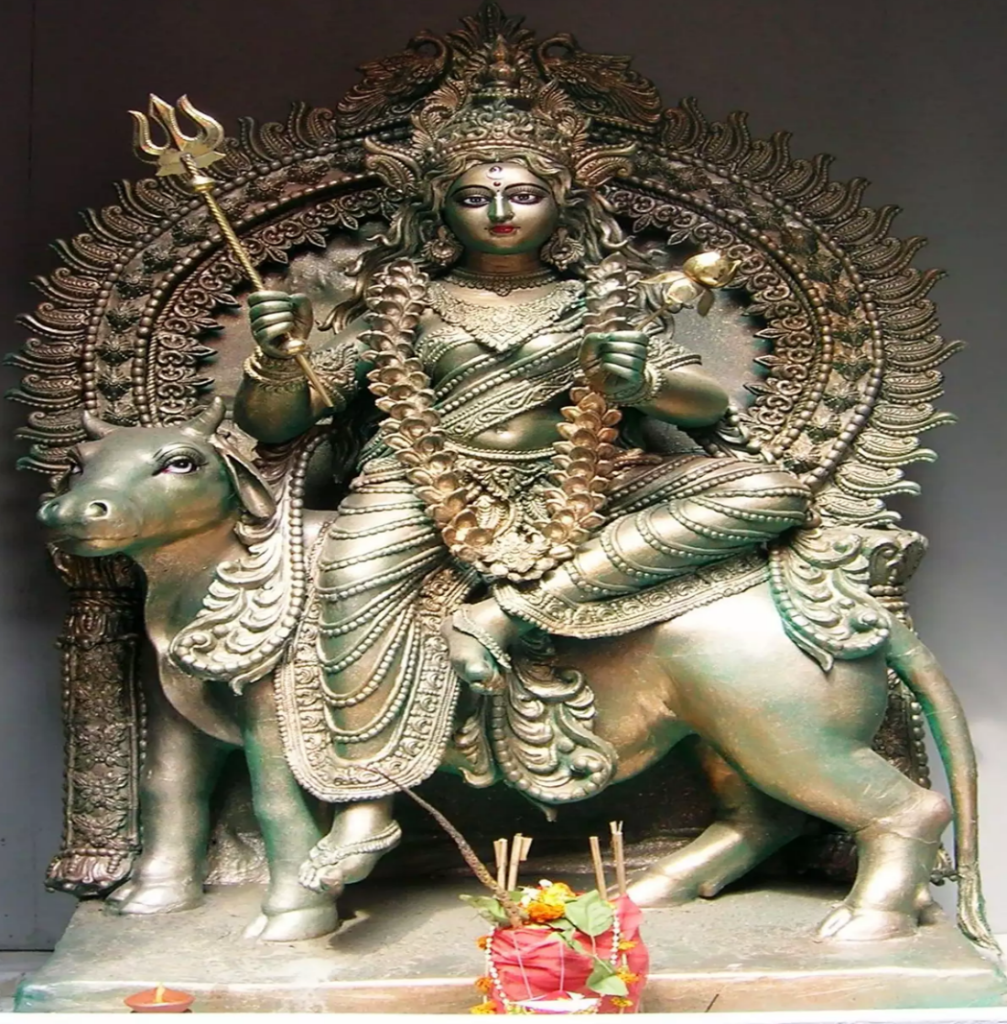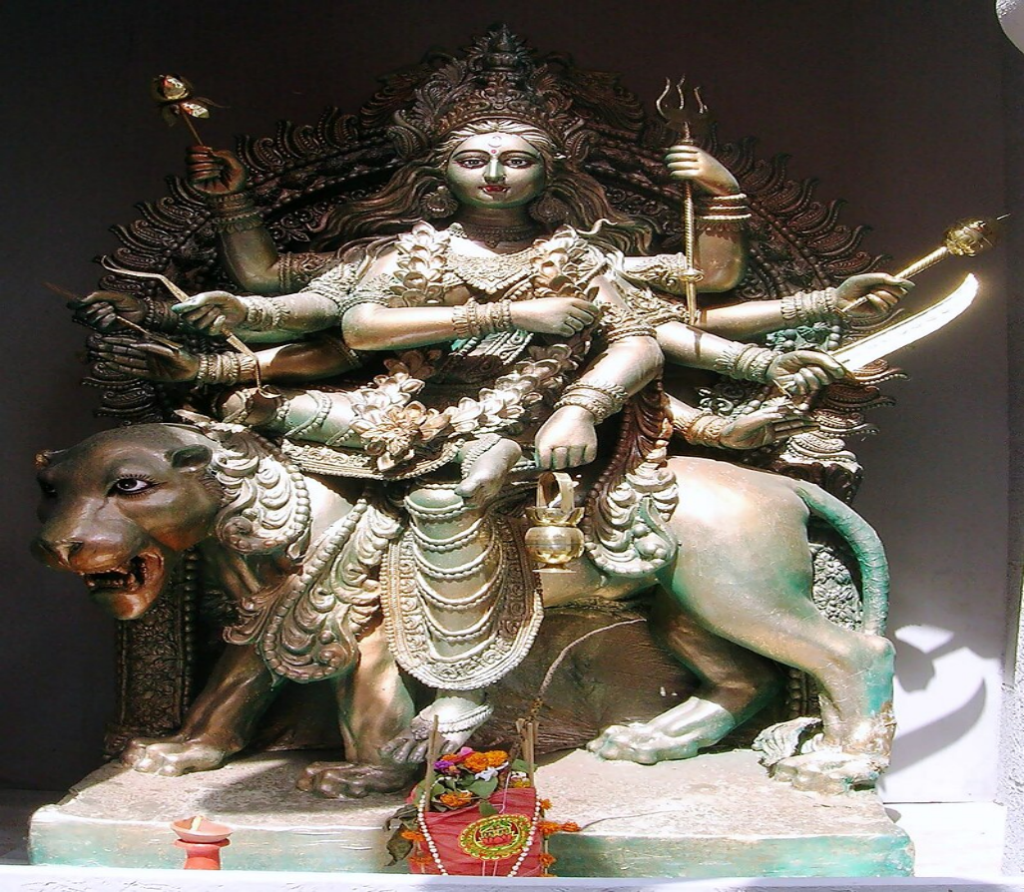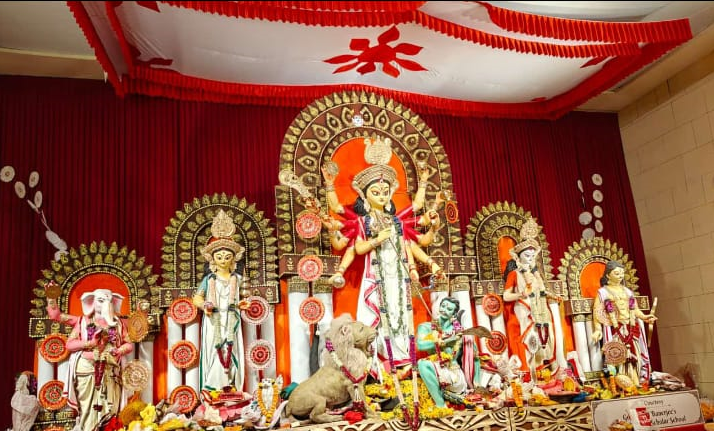Navaratri’s Power: Worshipping Durga in Nine Divine Forms
In the recently concluded article, “Veneration of the Dead”, the writer had been assiduous about the salient efficacy of venerations performed amongst the Hindu’s, while remaining taciturn. The finding is pertinacious – the conclusion of the veneration marks the commemoration of the month long festivals, commencing with “Navaratri, the worship of Mother Durga”.
Mother Durga the epitome of Superpower is worshipped by the Hindu’s across Nine-Days, and is revered in nine different forms with equal fervour each having its religious affirmations.

DAY 1 – Prothoma: Mother Shailaputri: –
Shailaputri is the first form amongst Navadurga or the nine forms and is worshipped on the first day during the Navratri celebrations. Also known as Sati, Bhavani, Parvati or Hemavati, Goddess Shailaputri is considered the absolute form of Mother Nature. In some cultures, she is also known as Goddess Parvati, wife of Lord Shiva, the mother of Ganesha and Kartikeya. The Goddess is depicted having a half moon on her forehead, holding a trident in her right hand and a lotus in her left while riding Nandi, the bull.
Born as the daughter of Himalaya and first, among the Navdurgas, Shailaputri literally means daughter (Putri) of the mountain (Shaila). According to the mythology, Shailaputri was born in the house of the King of Mountains, Himalayas and was thus known as “Shailaputri”.
Devi Shailaputri has been considered the embodiment of patience and upon awakening begins her journey from her father to her husband from the Muladhara Chakra or the root chakra which in yogic terms is said to be the base from which the three main psychic channels emerge. Muladhara is considered the foundation of the “energy body” or the “Shakti”. The ultimate search for her husband requires patience and devotion which Devi Shailaputri exemplifies. In Navratri pooja, the first day is dedicated to Yogi’s keeping their mind concentrated on Muladhara to generate energy. This is the starting point of their spiritual discipline. They start their sadhana from here. “Shailaputri” is thus the Muladhara Shakti to be realised within self and is sought for higher depths in the yogic meditation.
As per Upanishad, she reduced the egotism of Indra and the other Gods. Being ashamed, they bowed and prayed that, “In fact, thou are Shakti, we all – Brahma, Vishnu and Shiva are capable of getting Shakti from you.” Thus, Shailaputri is considered the manifestation, of the power of Brahma, Vishnu, and Shiva.
The colour of this day is “Yellow – which depicts action and vigour”. She is also considered to be a reincarnation of Sati (Shiva’s first wife, who then reincarnates as Parvati) and is also known as Hemavati.
Yellow is the colour people most often associate with amusement, gentleness, humour, happiness, and spontaneity; In Iran it has connotations of wisdom and connection. In China and many Asian countries, it is seen as the colour of royalty, nobility, respect, happiness, glory, harmony and wisdom.
DAY 2 – Dwitiya: Mother Brahmacharini: –
On Dwitiya (second day), Goddess Brahmacharini (Unmarried in Spirituality), another incarnation of Parvati, is worshipped. In this form, Parvati became Yogini, her unmarried & spiritual self.

‘Brahmacharini’ stems from two Sanskrit roots – Brahma (Brahman), means “the one self-existent Spirit, the Absolute Reality, Universal Self, Personal God, the sacred knowledge”, & Charini is the feminine version of one who is a Charya (way of life).
The word ‘Brahmacharini’ in Vedic texts means a female who pursues sacred religious knowledge, and is worshipped for emancipation or moksha and endowment of peace and prosperity. Depicted as walking bare feet and holding a Rudrakshmala (Japamala), her adorned ornament – which becomes the most important item associated with her in her forest life while she prays penance for Lord Shiva. It also bespeaks about her austerities and penance; a Kamandala (water pot) in her hands, which symbolises that in her final years of Tapasya she reduced her diet to plain water and nothing else. This is the reference to her being called ‘Aparna’.
Mother is also symbolised with lotus attached to various parts of her body. Even her ear kundalas are two lotuses pointing towards the ground. Lotus symbolises knowledge. The lotus plant grows from the mud of ignorance to seek light of knowledge. Towards that it grows above the water level epitomising a naive aspiring spiritual ascent.
Mother is usually dressed in white saree to represent purity, which signifies bliss & calm too. Hence, White is the Colour of the Day. She adorns a prominent crown just as Goddess Durga. This shows her majestic view despite her simplicity. Brahmacharini is always depicted with a smile and a very pleasing face.
DAY 3 – Tritwiya: Mother Chandraghanta: –
On Tritwiya, Chandraghanta is worshipped – the name derived from the fact that after marrying Shiva, Parvati adorned her forehead with the ‘Ardha Chandra (half-moon)’. She is the embodiment of beauty and is also symbolic of bravery. Her third eye is always open, signifying her perpetual readiness for battle against evil. She is also known as Chandrakhanda – the fearsome form of Parvati, with the knife in one hand and Ghanta in the other; Moon on the forehead, and sitting on a wolf (Vrikah) is named Chandraghanta by Brahma Dev.

Chandraghanta has ten hands where two hands hold a Trishula (trident), Gada (mace), bow-arrow, Khadhga (sword), Kamala (lotus flower), Ghanta (bell) and Kamandala (waterpot), while one of her hands remains in blessing posture or “Abhay Mudra (Fear dispelling)”. She rides on a wolf as her vehicle, which represents bravery and courage, she wears a half moon depicting a Bell on her forehead and has a third eye in the middle of her forehead. Her complexion is golden.
Shiva sees Chandraghanta’ s form as a great example of beauty, charm and grace, and later told Parvati that her battle to destroy Jatakasura would provide anyone the courage to overcome the fear of any battle and obstacles (inner or outer). Also, no woman is weak or helpless without her man, that is why she is also known as Vrikahvahini or Chandrika. She is believed to reward people with her grace, bravery and courage.
Grey is the colour of the third day, which is vivacious, and can cheer up everyone’s mood. The time when the Goddess fought against the demon Jatakasura, it was dark, and hence the colour Grey finds its inception.
To be continued…………

Writer Suvro Sanyal
Log on : www.mavericknews30.com
Follows us on : Twitter @mavericknews30
YouTube : @MarvickNews30
Adani Green Denies Allegations, Reaffirms Commitment to Governance and Compliance
The allegations made by the US Department of Justice and the US Securities and Exchange Co…

















